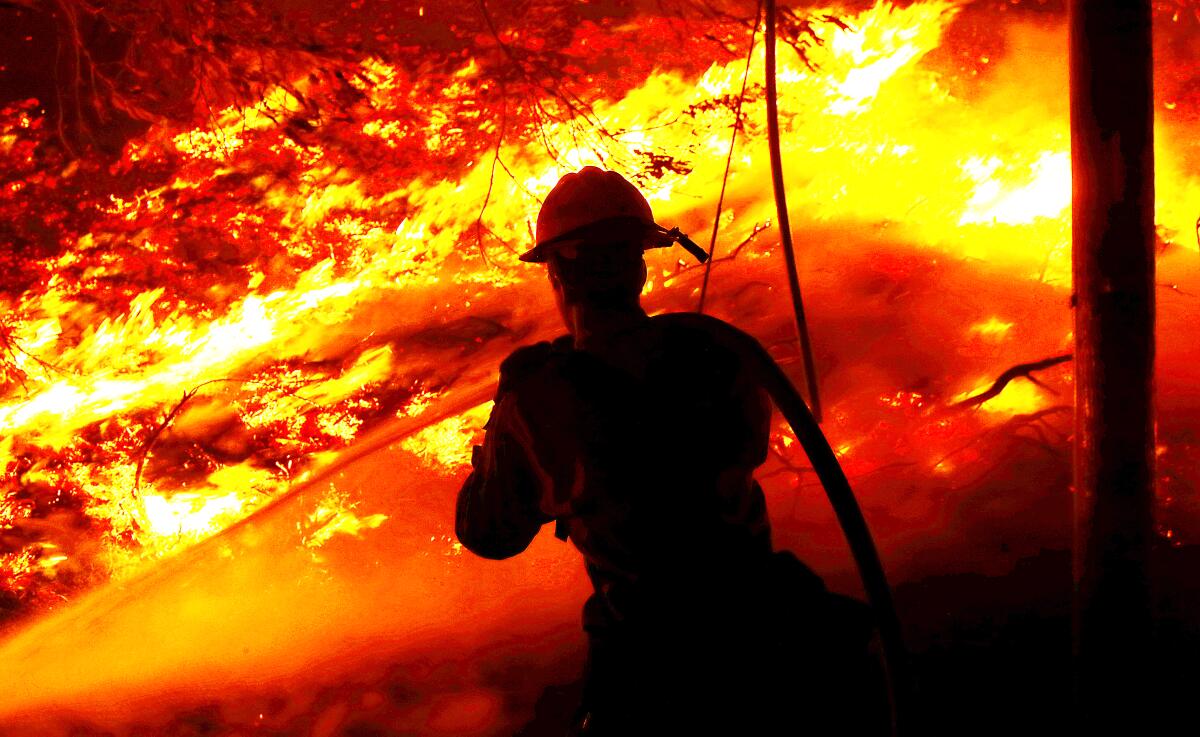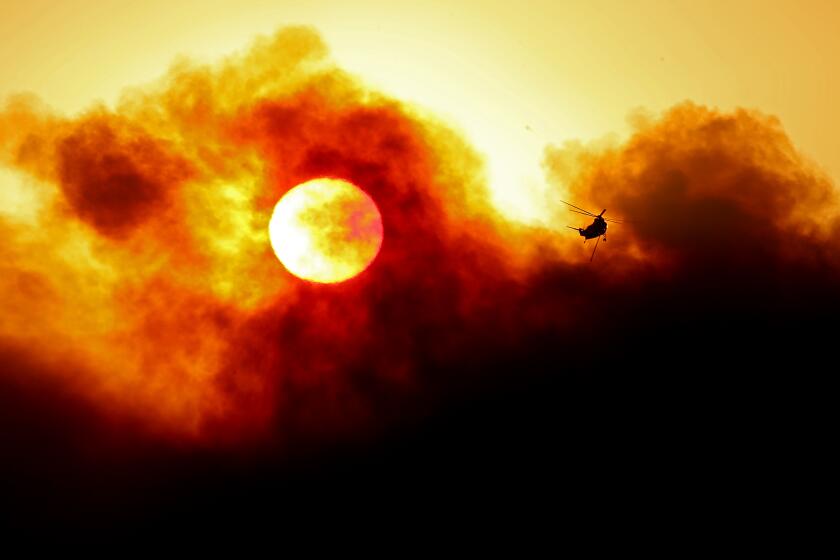Column: As California continues to burn, politicians must have their feet held to the fire

- Share via
SACRAMENTO — Wildfires have always menaced California and that will never stop, especially with climate warming. What we can do is make them more controllable and less catastrophic.
That’s what Gov. Gavin Newsom and the Legislature are attempting to achieve — a bit belatedly — by pouring unprecedented amounts of money into fire prevention.
Sacramento should have been doing this a long time ago. Blame internal squabbles, budget worries and a failure to prioritize the wildfire threat.
Don’t look for dramatic progress by the next fire season, although there should be incremental improvements. Given how far behind California is in addressing the wildfire challenge, and the natural snail’s pace of government — an agonizing trait of virtually any government — this will take many years of consistent effort and tanker loads of tax dollars.
There’s a sense in Sacramento of inevitability about major wildfires. Brush fires such as the Alisal blaze in Santa Barbara County have raged forever along the Southern California coast. The hills above Malibu are periodically torched.
But there’s also optimism that the fires can be made less horrific than the blazes that have destroyed tens of thousands of homes and entire towns in recent years.
“The good news is we actually know how to make California’s ecology climate-resistant. We’re not just sitting back and saying, ‘Good luck,’” says Jessica Morse, deputy secretary for Forest and Wildland Resilience at the state Natural Resources Agency.
Morse is a fifth-generation Californian whose family helped settle the tiny, historic, pine-forestedmining town of Gold Run in the Sierra east of Sacramento. She grew up there. For her, wildfires are “personal, emotional and serious,” she says.
Personally, I’m sick of hearing politicians — starting with Newsom — immediately blame climate change for our wildfire devastation. It comes across as: “Not my fault. Didn’t happen on my shift.”
Well, it is their shift now. What are they doing about it? Certainly, climate change exacerbates wildfires by drying out vegetation and making the blazes hotter and more volatile.
But, as Morse told me, “the climate crisis is not going to reverse overnight.”
Fueled by bone-dry vegetation, the Alisal fire has burned 13,000 acres and is 5% contained.
We must cope with the wildfire threat that exists today, not just use it as a talking point to whip up public support for slowing climate change. That’s what Newsom seems to do.
That said, 2021 has been a banner year for legislative and gubernatorial action on preventing and fighting wildfires.
“We’ve finally put our money where our mouth is,” says state Sen. Bill Dodd (D-Napa), whose wine country district north of San Francisco has been hit hard by wildfires. He’s a leader on fire legislation.
“Last year, we spent $3 billion on fire suppression and $100 million on fire prevention. That just doesn’t do it,” Dodd says. “This year we’re going to spend $3 billion on suppression and $1.5 billion on prevention.”
The prevention money will go toward a smorgasbord of projects.
One sorely needed project is thinning dense forests by removing highly flammable dead trees and thick underbrush.
Much of this thinning is carried out by so-called prescribed burning — what Indigenous Californians did to keep the forests healthy until Europeans shoved them aside and began dousing every small blaze to protect settlements and marketable timber.
“California’s ecology was managed beautifully for a millennia,” Morse says. “Then the West was colonized. ...As a result of multi-generation decisions and climate change, we’re now seeing catastrophic megafires.”
California forests became overgrown with people, pines and undergrowth. The dense trees became susceptible to disease — bark beetles in a drought — and nearly 170 million now are dead, creating hot-burning fire fuel.
Both the state and federal governments have been slow to respond to the modern reality that forests need to be periodically cleaned.
Bills on fishing licenses, ghost guns, jaywalking, bicycle laws and gas-powered lawn equipment were among those Newsom acted on
“We had a goal last year of treating 500,000 acres, but only did about 60,000” Dodd says.
Newsom signed a Dodd bill that will protect landowners from liability if prescribed burns on their forested property get out of control.
The record state spending also will be used to create cleared-out spaces — called “fuel breaks” — around forested communities where firefighters can safely place their equipment and battle blazes. Fuel breaks are credited with helping to save South Lake Tahoe in August.
The money also will provide grants for homeowners to create vegetation-light buffers — “defensible space” — next to their vulnerable houses.
There’ll be grants for “home hardening,” such as installing double-pane windows and finally getting rid of those wood-shingle roofs.
“This is a cultural thing,” says Thom Porter, chief of the California Department of Forestry and Fire Protection. “We’re seeing fires that we’ve never seen in history, like redwoods burning because they’re so dry. We need to embrace that fact and prepare our communities to be resilient.
“It’s for certain going to cost a ton of money and require sustained activity.”
Another Dodd bill signed by Newsom will create a new Office of Wildfire Technology Research to test better equipment and retardants.
“We’re behind the curve on this,” Dodd says.
As of Friday, roughly 2.5 million acres had been burned in California this year by more than 8,000 fires, dooming 3,600 structures. Last year, 4.3 million acres were burned and nearly 10,500 structures destroyed.
Reducing the wildfire threat should be state government’s top priority. It’s about public safety, shattered lives, crippled local economies, toxic smoky skies, and greenhouse emissions making climate warming even worse.
These last few years cannot become the status quo. That’s unacceptable. The public needs to hold the politicians’ feet to the fire.
More to Read
Sign up for Essential California
The most important California stories and recommendations in your inbox every morning.
You may occasionally receive promotional content from the Los Angeles Times.













